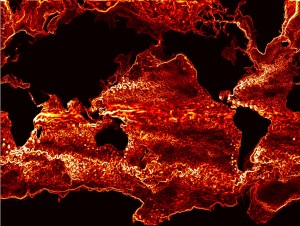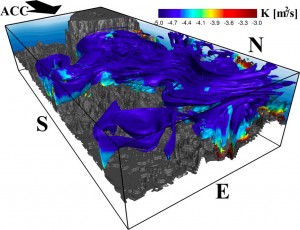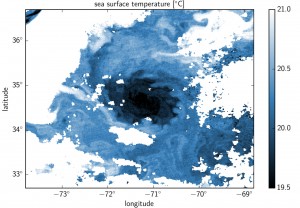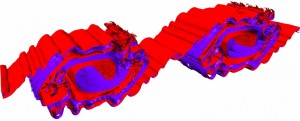Ocean Turbulence
 The ocean circulation is turbulent in the sense that motions on wide range of scales from a few centimeters to thousand of kilometers continuously interact. In order to develop theories of the large-scale circulation, which affects our climate, we need to understand these interactions. Our group tackles motions on all these scales using a combination of observation, turbulence theories and high resolution numerical models (like the one shown in the picture of ocean surface velocities–light red means higher velocities.) One of the major challenges is to understand how energy is transferred from the thousand of kilometers scales, where oceanic motions are forced by the large-scale atmospheric winds and heat/freshwater fluxes, to the centimeters scales, where energy is dissipated as heat. The first major transfer is from the large-scale currents to the mesoscale eddies. The large-scale ocean currents are unstable to baroclinic instability which generate eddies with scales of 10 to 100 kilometers, the mesoscales. The mesoscale eddies then interact and generate submesoscale turbulent filaments on scales from 10 kilometers to 100 meters. These motions are primarily horizontal constrained by the ocean stratification and rotation. Only at scales below approximately 100 meters, the turbulence becomes three-dimensional and it is described as stratified microscale turbulence. Some of the themes we are actively working on are listed below.
The ocean circulation is turbulent in the sense that motions on wide range of scales from a few centimeters to thousand of kilometers continuously interact. In order to develop theories of the large-scale circulation, which affects our climate, we need to understand these interactions. Our group tackles motions on all these scales using a combination of observation, turbulence theories and high resolution numerical models (like the one shown in the picture of ocean surface velocities–light red means higher velocities.) One of the major challenges is to understand how energy is transferred from the thousand of kilometers scales, where oceanic motions are forced by the large-scale atmospheric winds and heat/freshwater fluxes, to the centimeters scales, where energy is dissipated as heat. The first major transfer is from the large-scale currents to the mesoscale eddies. The large-scale ocean currents are unstable to baroclinic instability which generate eddies with scales of 10 to 100 kilometers, the mesoscales. The mesoscale eddies then interact and generate submesoscale turbulent filaments on scales from 10 kilometers to 100 meters. These motions are primarily horizontal constrained by the ocean stratification and rotation. Only at scales below approximately 100 meters, the turbulence becomes three-dimensional and it is described as stratified microscale turbulence. Some of the themes we are actively working on are listed below.
Mesoscale Turbulence
 The ocean circulation is dominated by geostrophic eddies, i.e. cyclones and anticyclones with radii of 10-100 kilometers. These eddies are the ocean equivalent of the storms we experience in the atmosphere as weather. On the left we show a dye stirred by geostrophic eddies in a numerical simulations of the Southern Ocean. Eddies play an important role in the transport of heat, carbon and other climatically important tracers across the oceans. Our group is very active in this research area. We develop theories for the physics of ocean eddies, their role in climate, and their representation in numerical models used for climate studies. Prof. Ferrari led a Climate Process Team aimed at improving the representation of ocean eddies in climate models. Our group has been actively involved in a number of field campaigns: the Southern Ocean, the Diapycnal and Isopycnal Mixing Experiment (http://dimes.ucsd.edu/en/), where we measured eddy mixing in the Southern Ocean, and the Climate Mode Water Experiment, focused on the role of eddies in the formation of intermediate waters (http://www.climode.org/). A major outcome of these studies is that lateral mixing by mesoscale eddies is suppressed across strong currents, while it is strong on the flanks of the currents. We have also shown that these variations in lateral mixing are crucial to quantify the impact of mesoscale eddies on the large-scale ocean circulation and climate.
The ocean circulation is dominated by geostrophic eddies, i.e. cyclones and anticyclones with radii of 10-100 kilometers. These eddies are the ocean equivalent of the storms we experience in the atmosphere as weather. On the left we show a dye stirred by geostrophic eddies in a numerical simulations of the Southern Ocean. Eddies play an important role in the transport of heat, carbon and other climatically important tracers across the oceans. Our group is very active in this research area. We develop theories for the physics of ocean eddies, their role in climate, and their representation in numerical models used for climate studies. Prof. Ferrari led a Climate Process Team aimed at improving the representation of ocean eddies in climate models. Our group has been actively involved in a number of field campaigns: the Southern Ocean, the Diapycnal and Isopycnal Mixing Experiment (http://dimes.ucsd.edu/en/), where we measured eddy mixing in the Southern Ocean, and the Climate Mode Water Experiment, focused on the role of eddies in the formation of intermediate waters (http://www.climode.org/). A major outcome of these studies is that lateral mixing by mesoscale eddies is suppressed across strong currents, while it is strong on the flanks of the currents. We have also shown that these variations in lateral mixing are crucial to quantify the impact of mesoscale eddies on the large-scale ocean circulation and climate.
Now working on this theme: Andre Souza.
Previously working on this theme: Andreas Klocker, Maxim Nikurashin, Ross Tulloch, Yu Zhang, Madeleine Youngs.
Submesoscale turbulence
 Submesoscale flows are a convoluted web of fronts, with horizontal scales between 10 kilometers and 100 meters, that separate waters of different temperatures and salinities. The importance of submesoscale fronts have increasingly come into focus as an important component of ocean dynamics, in particular after the work of the Climate Process Team led by Prof. Ferrari. The submesoscale fronts are most energetic close the ocean surface. Just as alveoli facilitate rapid exchange of gases in the lungs, fronts are the ducts through which heat, carbon, oxygen and other climatically important tracers enter into the deep ocean. Our group participated in two observational programs to study submesoscale flows: the Spice Experiment in the North Pacific (http://chowder.ucsd.edu/Rudnick/Spice.html) and the Latmix Experiment in the North Atlantic (http://www.bco-dmo.org/project/2160). We were able to show that the submesoscale fronts are generated through instabilities of mesoscale currents confined to the surface mixed layer. The instabilities are stronger in winter and thus submesoscale flows are stronger in winter than in summer. A developing submesoscale instability is visible as undulations along the rim of a geostrophic eddy in the satellite picture of surface color shown above. We are now collaborating with NASA to develop a new altimeter to observe fronts from space, the Surface Water Ocean Topography mission (https://swot.jpl.nasa.gov/).
Submesoscale flows are a convoluted web of fronts, with horizontal scales between 10 kilometers and 100 meters, that separate waters of different temperatures and salinities. The importance of submesoscale fronts have increasingly come into focus as an important component of ocean dynamics, in particular after the work of the Climate Process Team led by Prof. Ferrari. The submesoscale fronts are most energetic close the ocean surface. Just as alveoli facilitate rapid exchange of gases in the lungs, fronts are the ducts through which heat, carbon, oxygen and other climatically important tracers enter into the deep ocean. Our group participated in two observational programs to study submesoscale flows: the Spice Experiment in the North Pacific (http://chowder.ucsd.edu/Rudnick/Spice.html) and the Latmix Experiment in the North Atlantic (http://www.bco-dmo.org/project/2160). We were able to show that the submesoscale fronts are generated through instabilities of mesoscale currents confined to the surface mixed layer. The instabilities are stronger in winter and thus submesoscale flows are stronger in winter than in summer. A developing submesoscale instability is visible as undulations along the rim of a geostrophic eddy in the satellite picture of surface color shown above. We are now collaborating with NASA to develop a new altimeter to observe fronts from space, the Surface Water Ocean Topography mission (https://swot.jpl.nasa.gov/).
Now working on this theme: Henri Drake.
Previously working on this theme: Joern Callies, Baylor Fox-Kemper, John Taylor.
Microscale turbulence
 Oceanic motions with horizontal scales larger than 1 kilometer and vertical scales larger than 100 meters are constrained to flow along density surfaces by the Earth’s rotation and the density stratification. However at smaller scales, the so-called microscales, these constraints become weak and turbulent motions cross density surfaces. In the upper ocean, microscale turbulence is generated by surface winds, air-sea cooling or evaporation. In the ocean interior, microscale turbulence develops when internal waves develop strong shears and overturn and break, much like surface gravity waves. These breaking events play a fundamental role in the ocean circulation, because they mix the densest waters at the ocean bottom with the lighter waters above, thereby allowing the densest waters to come back to the surface. Our group has shown that most of these transformation happens along deep ocean boundaries and not in the ocean interior, as previously believed. We are also studying how the deep internal waves are generated and what fraction of these waves break and mix the deep ocean.
Oceanic motions with horizontal scales larger than 1 kilometer and vertical scales larger than 100 meters are constrained to flow along density surfaces by the Earth’s rotation and the density stratification. However at smaller scales, the so-called microscales, these constraints become weak and turbulent motions cross density surfaces. In the upper ocean, microscale turbulence is generated by surface winds, air-sea cooling or evaporation. In the ocean interior, microscale turbulence develops when internal waves develop strong shears and overturn and break, much like surface gravity waves. These breaking events play a fundamental role in the ocean circulation, because they mix the densest waters at the ocean bottom with the lighter waters above, thereby allowing the densest waters to come back to the surface. Our group has shown that most of these transformation happens along deep ocean boundaries and not in the ocean interior, as previously believed. We are also studying how the deep internal waves are generated and what fraction of these waves break and mix the deep ocean.
Now working on this theme: Ali Ramadhan, Andre Souza, Gregory Wagner.
Previously working on this theme: Malte Jansen, Ali Mashayek, Maxim Nikurashin.